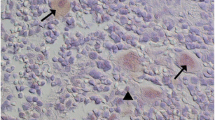Abstract
Thein vitro metabolism of14C-cadaverine by diamine oxidase was investigated in various tissues of pregnant and non-pregnant rats. The metabolites formed were: Δ1-piperideine, δ-aminovaleric acid, carbon dioxide and some unidentified compound(s). In most of the tissues investigated Δ1-piperideine was the predominant metabolite, but considerable amounts of δ-aminovaleric acid and the unidentified compound(s) were also formed. The oxidative products of cadaverine might be of importance in various physiological and pathophysiological connections associated with elevated diamine oxidase levels.
Similar content being viewed by others
References
A.-Ch. Andersson, S. Henningsson andE. Rosengren,Increased formation of diamines and polyamines in the pregnant rat. J. Physiol., Lond.285, 311–324 (1978).
Y. Kobayashi,Plasma diamine oxidase titres of normal and pregnant rats, Nature, Lond.203, 146–147 (1964).
M. Roberts andJ.M. Robson The histaminase content of the rat uterus, and its relation to the decidua. J. Physiol., Lond.119, 286–291 (1953).
K.S. Kim andM.E. Harris, Mechanism of increased diamine oxidase activity in pregnancy and the possible roles of diamine oxidase in the uterus and the ovary. InHistamine int. Congr. Physiol. Sci. pp. 312–326 (Ed.Cz. Maslinski) 1973.
C. Schöpf, A. Komzak, F. Braun, E. Jacobi, M.-L. Bormuth, M. Bullnheimer andI. Hagel, Über die Polymeren des Δ1-Piperideine, Justus Liebigs Annln Chem.559, 1–42 (1948).
T. Okuyama andY. Kobayashi,Determination of diamine oxidase activity by liquid scintillation counting, Archs Biochem. Biophys.95, 242–250 (1961).
C. de Marco andB. Mondovi,Identification of δ-aminovalerianic acid in the urine of rats injected with cadaverine, Ital. J. Biochem.9, 226–232 (1960).
A.-Ch. Henningsson andS. Henningsson,Metabolism of cadaverine in vivo of the pregnant rat, to be published.
R.W. Schayer, R.L. Smiley andJ. Kennedy,Diamine oxidase and cadaverine metabolism, J. biol. Chem.206, 461–464 (1954).
A.-Ch. Andersson, S. Hennningsson, L. Persson andE. Rosengren,Aspects on diamine oxidase activity and its determination, Acta physiol. scand.102, 159–166 (1978).
A.-Ch. Andersson andS. Henningsson,Metabolism of putrescine in the pregnant rat, Acta physiol. scand.113, 523–532 (1981).
S. Henningsson,Automated liquid chromatography in research on histamine metabolism, Agents and Actions8, 392–393 (1978).
A.-Ch. Andersson, S. Henningsson andE. Rosengren,Formation of cadaverine in the pregnant rat, Acta physiol. scand.105, 508–512 (1979).
C.F. Baxter, The nature of γ-aminobutyric acid. InHandbook of Neurochemistry, vol. 3, pp. 289–353 (Ed.Lajtha). Plenum Press, New York, London 1970.
Author information
Authors and Affiliations
Rights and permissions
About this article
Cite this article
Henningsson, AC., Henningsson, S. In vitro metabolism of cadaverine in the pregnant rat. Agents and Actions 13, 262–264 (1983). https://doi.org/10.1007/BF01967348
Issue Date:
DOI: https://doi.org/10.1007/BF01967348




